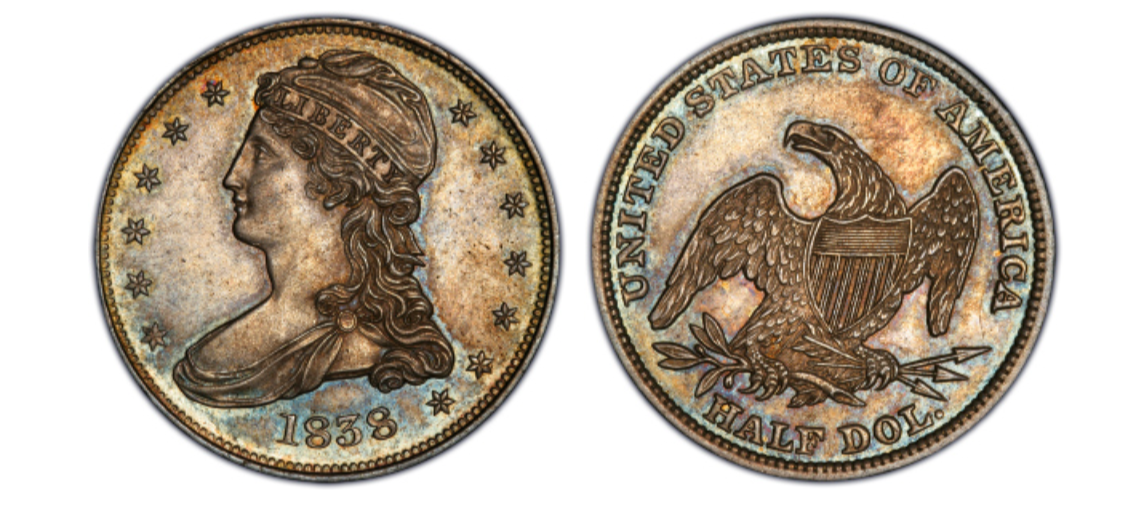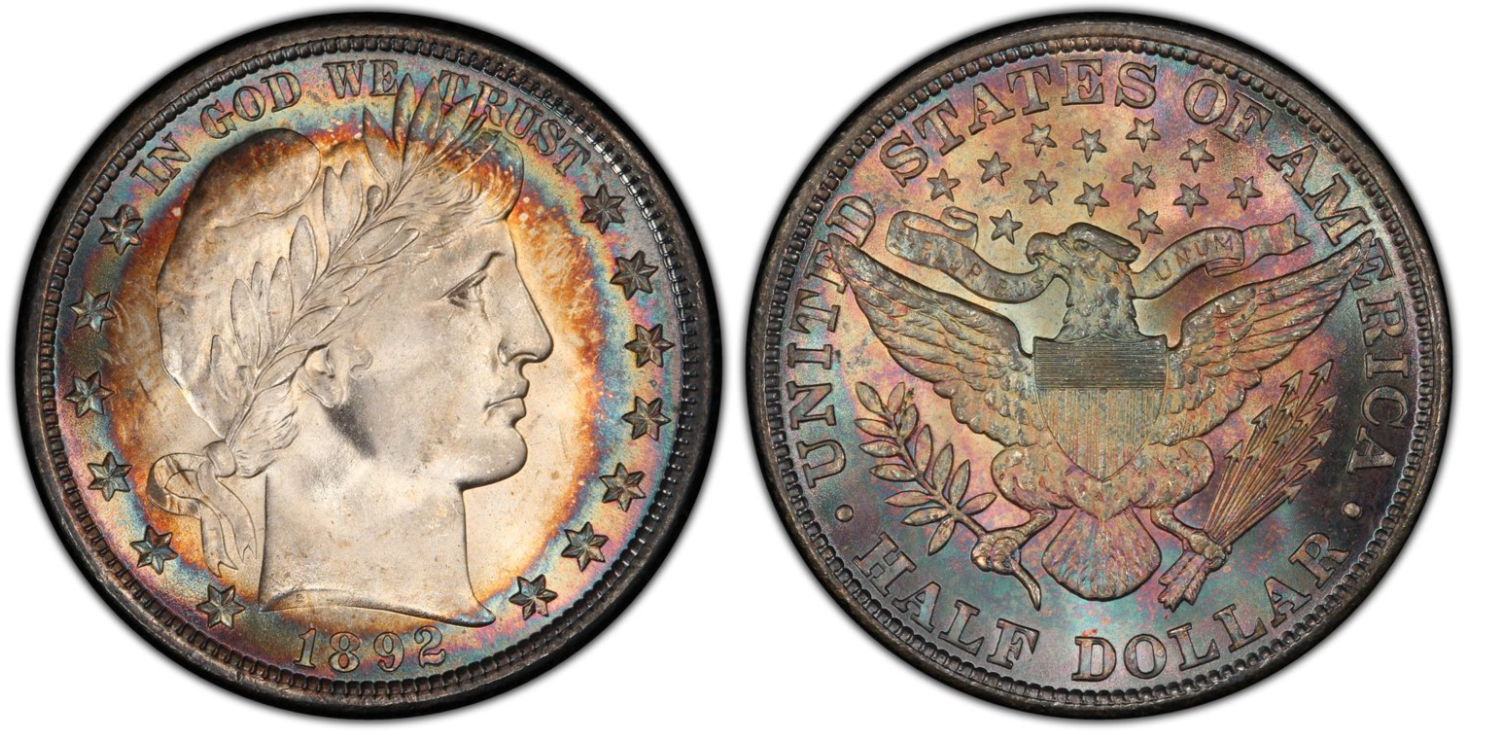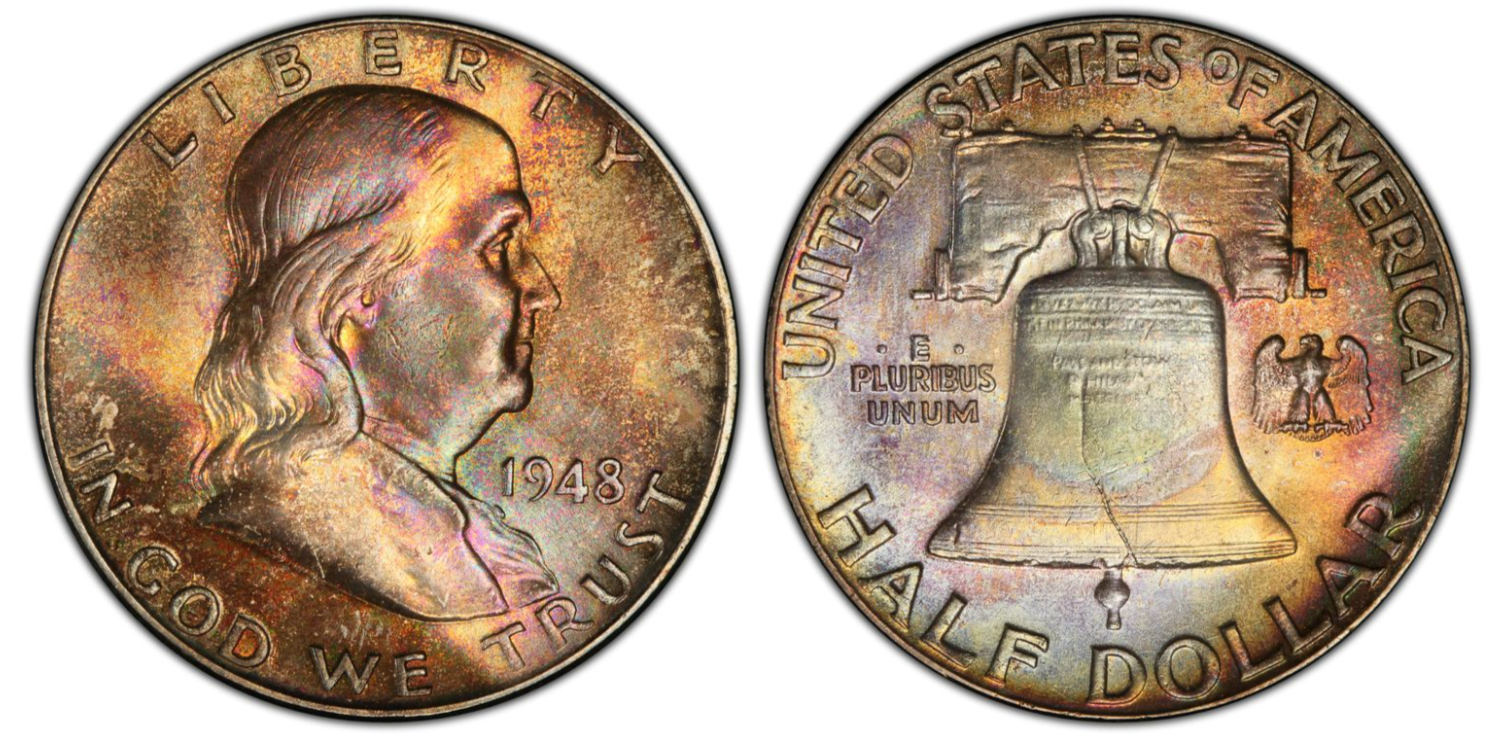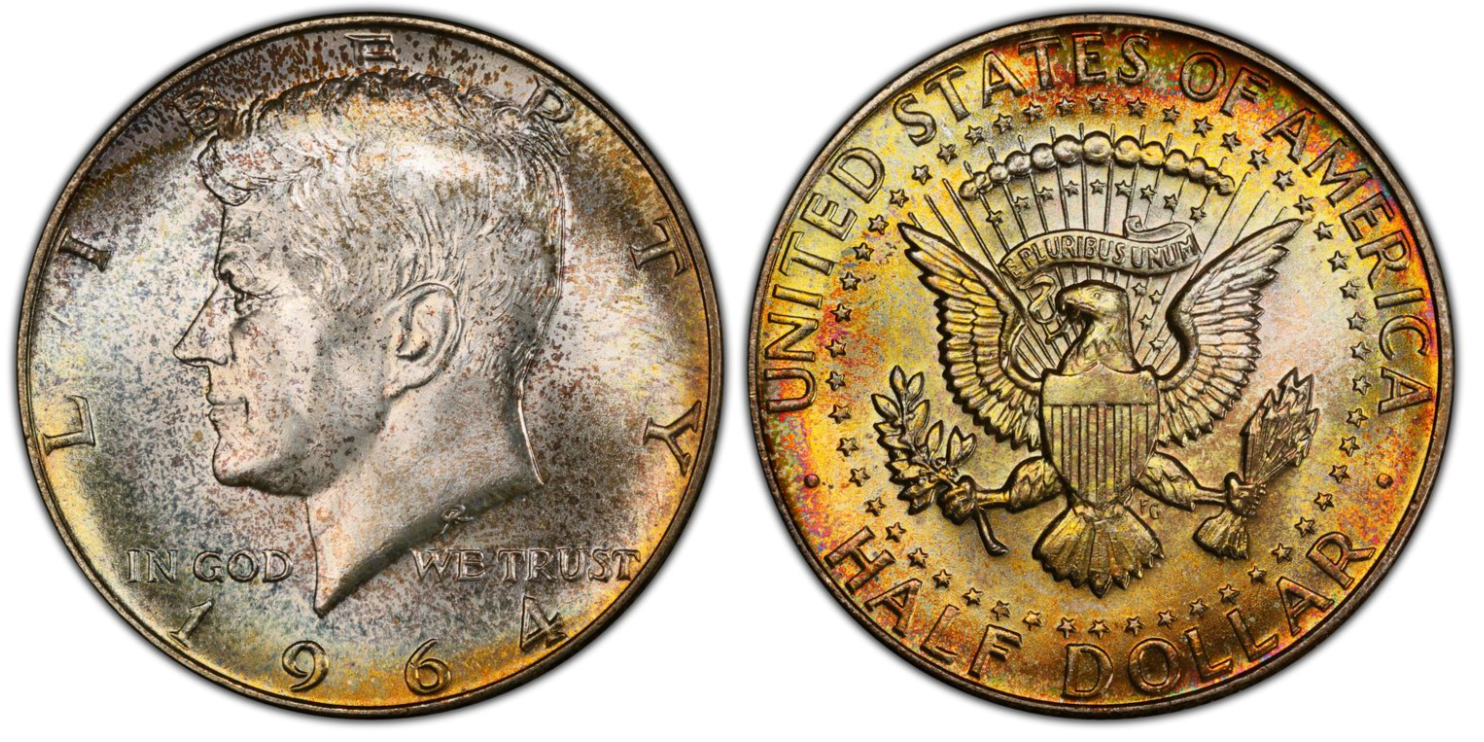Silver Half Dollars Values and Types
Posted by Andrew Adamo on Mar 12th 2024
Rare Half Dollar Coin Guide:
Silver Half Dollars Value
I’m sure we all have had a Kennedy half dollar in our pockets. Some of the Half Dollars still can be found in circulation today, how to know if their value is more than 50 cents? Which half dollars are silver? In this article we will cover main silver half dollars, rare half dollar coins, tips how to tell their value and which half dollars worth collecting.
Which half dollars are made from silver and how much silver do dollars carry today?
You might have heard about Kennedy, Barber, Walking Liberty or Franklin half dollars. No wonder! These are the most common faces of the iconic 90% half dollars. Why are these US coins so popular?
Silver half dollars issued by the United States Mint in 1964 and earlier, were composed of 90% silver. After the Coinage Act of 1965, the composition of half dollars dropped from 90% silver to 40% silver. The half dollar composition changed again in 1971, when the U.S. began minting coins composed of 75% copper and 25% nickel which removed any remaining silver content. Today, half dollars are still made with copper and nickel.
While 90% silver half dollar coins are no longer produced by the U.S. many still exist and are in demand among coin buyers. In fact, 90% silver halves are some of the most popular US silver coins amongst collectors.
A lot of factors, such as condition, rarity, year, and mint location impact on the value of certain coins. In this article, we will identify which half dollars can trade at a significant premium, and which sell based on their underlying silver content to help you make a better decision when you buy and sell silver half dollars.
Bust Silver Half Dollars: 1794 – 1839
Image source: PCGS
The Bust Half dollars played an important part in American History as these were some of the first coins produced by the US Mint. Bust half dollars have three different design types (Flowing Hair, Draped, Capped) minted consecutively between 1794 and 1839.
Flowing Hair Half Dollar (1794 – 1795)
Flowing Hair U.S. half dollars were the first of the three design types produced for only a very short period of time from 1794–1795, followed by the Draped Bust half dollars (1796–1807), and lastly, Capped Bust half dollars (1807–1839).
It’s no surprise the Flowing Hair half dollars, which also happen to have the lowest mintage as the three were only produced for two years, trade at the highest values. In fact, Flowing Hair half dollar coins can sell for thousands of dollars, but finding them in a good condition can be extremely difficult due to their age and availability. Yet, these continue to be sought after coins by collectors.
Two years after the Flowing Hair half dollar was placed into circulation, the first U.S. Minted half dollar was redesigned to what is now known as the Draped Bust half dollar. Designed by Robert Scot, who was the first Chief Engraver of the U.S. Mint, it was inspired by the work of portraitist Gilbert Stuart and his portrayal of Liberty. There were two different designs of the Draped Bust half dollar one of which has considerably more value than the other.
Image source: PCGS
An entire article could be devoted to Bust Half Dollars. In brief, among the two distinct reverse designs, the version featuring a small eagle stands out as one of the most uncommon and sought-after silver types in the realm of American coin collecting. This specific design, notable for its rarity, was minted for a brief period, from 1796 to 1797. The value of these coins is remarkable, with estimates ranging between $10,000 and $125,000, reflecting their scarcity and historical significance.
Transitioning from the exceedingly rare Bust half dollar, we encounter the more accessible Capped Bust half dollar, a favorite among collectors. When found in circulated condition, these coins typically fetch between $50 and $200, sometimes even higher. The value of this coin escalates particularly in the almost uncirculated (AU) grade. Certified uncirculated specimens of the Capped Bust half dollar often command prices exceeding $1,000, reflecting their higher quality and desirability among numismatists.When considering adding a certified Bust half dollar to your coin collection, there are factors to consider that will impact not only the price you’ll pay but also the value you ultimately receive when it comes time to sell. The same factors can apply to any coin and so they are good points to remember.
- Date & Mintmark: when collecting any coin, the date and mintmark are a key factor to consider their value. Each mint produced different quantities of coins and each year had a different production number. For example, 300,000 Flowing Hair Bust half dollars were produced while only 3,918 Draped Bust with small eagle reverse were produced.
- Grade & Condition: is key when it comes to determine coin value. One tier difference can mean thousands of dollars! If you’re in the market to add a valuable half dollar to your collection, we recommend that you focus on those that have been certified by top third-party grading service (TPGS) companies such as NGC or PCGS. They tend to be more consistent in their grading practices and are accepted as the industry standard.
Seated Liberty Half Dollars: 1839 – 1891
Seated Liberty half dollars were minted after the Capped Bust half dollar and before the Barber half dollar, the Seated Liberty half dollars were minted from 1839 to 1891. This coin features a classic depiction of Lady Liberty seated on a rock, elegantly draped in a flowing gown. In her right hand, she holds a shield, while her left hand grasps a liberty pole, crowned with a Phrygian cap, symbolizing freedom. The Seated Liberty half dollar comes in multiple varieties, distinguished by details such as drapery, arrows, and rays, or their absence, adding to its historical and collectible value.
Image source: PCGS
While not as valuable as Capped Bust half dollars, values in circulated condition typically range between $25 – $100 but can reach into the hundreds of dollars if you have a low mintage coin or if in certified uncirculated condition. As previously mentioned, coins authenticated and graded by reputable organizations like NGC or PCGS are particularly favored among collectors, often fetching the highest prices on the resale market.
Speaking of a high resale, the highest price realized for a Seated Liberty half dollar is $517,000 for the 1853-o half dollar, no arrows or rays. Only four such coins exist. Unfortunately, these coins rarely come to market, with the last having sold at auction in 2017.
Barber Silver Half Dollars: 1892 – 1915
Barber half dollars were designed by Charles E. Barber and were produced from 1892–1915. Barber half dollars, typically minted in substantial quantities, are often found in considerably worn condition due to their extensive circulation over many years. Despite this, there are a few key date or lower mintage Barber half dollars that exist, and these particular coins can command higher prices in the collectors' market, reflecting their rarity and historical value.
Image source: PCGS
It's important to note that the majority of half dollars minted before 1897 were produced in smaller quantities. This also includes specific years like the 1904-S, 1913-P, 1914-P, and 1915-P half dollars. Among the Barber half dollars, excluding proof coins, the most sought-after is the 1892-o. The micro "O" variant of this coin, characterized by a smaller mint mark, typically fetches a higher price than its standard-sized "O" counterpart.
As mentioned earlier, Barber half dollars experienced extensive circulation, so even those from common dates, when found in higher-end conditions such as Very Fine or better, command a premium in the market. Their historical significance and relative scarcity in such conditions add to their appeal among collectors.
Walking Liberty Silver Half Dollars: 1916 – 1947
The U.S. Mint produced Walking Liberty half dollars between 1916 and 1947. While most Walking Liberty half dollars are of common dates, a select few stand out in terms of value, particularly when found in high-end or certified conditions.
Especially coveted are Walking Liberty halves from 1916, 1919, and 1921. The 1921-P and 1921-D versions, in particular, are known to fetch the highest prices. Coins from these years produced in limited quantities are regarded as rare or scarce and can command hundreds of dollars, sometimes even more, when in top condition. However, these high-value dates and coins are more exceptions than the norm.
Collecting a complete set of Walking Liberty coins in circulated condition is a relatively accessible goal, achievable with a modest budget. The enduring appeal of the Walking Liberty image, which inspired the design of the American Silver Eagle, coupled with the popularity of these coins, makes them a potentially excellent long-term investment.
Image source: PCGS
Franklin Silver Half Dollars: 1948-1963
The Franklin Half Dollars, featuring a design by John Sinnock with assistance from Gilroy Roberts, showcase a profile view of Benjamin Franklin on the obverse and the Liberty Bell on the reverse. Minted from 1948 to 1963, these coins had one of the shorter production spans in U.S. minting history. Despite this brief period, a significant number were produced.
In total, around 460 million Franklin Half Dollars were minted over these 16 years, averaging nearly 29 million coins annually. Given this substantial mintage, these coins are relatively common. Those in average circulated condition or with moderate wear are typically valued for their silver content rather than any numismatic premium.
Shop all Franklin Half Dollars >
Often referred to as “junk silver,” these coins, minted before 1965, are composed of 90% silver. This makes it unnecessary to check the minting date of Franklin Half Dollars to ascertain their silver content. A handy guideline for those interested in the silver weight of these coins is that approximately three silver half dollars equate to one troy ounce of silver.
However, certain Franklin Half Dollar coins, especially the proof versions minted from 1950 to 1953 and specific high-end condition coins like the 1949-S and 1952-S, possess numismatic value beyond their silver content. These particular coins can fetch higher prices among collectors due to their rarity and condition.
Image source: PCGS
1964 Kennedy Silver Half Dollars: (currently issued)
In the wake of President John F. Kennedy's assassination on November 22, 1963, Congress swiftly authorized the creation of the Kennedy half dollar. Designed by Gilroy Roberts, these coins feature a profile portrait of President Kennedy on the obverse and a heraldic eagle clutching an olive branch on the reverse.
The 1964 Kennedy silver half dollars, with a total of 433 million coins minted at both the Philadelphia and Denver mints, are relatively common. Their value is closely tied to the spot price of silver, reflecting their silver weight of .3616 ounces. It's crucial to note that only the 1964 Kennedy half dollars are made of 90% silver. Hence, verifying the date is essential when determining whether you are dealing with silver coins or those made of nickel-copper.
Shop all Kennedy Half Dollars >
The proof version of the 1964 Kennedy half dollar, minted at the Philadelphia Mint, is another sought-after variant. Out of a total of 3.95 million coins, two distinct types exist. The standard proof version mirrors the obverse design of the regular business strike half dollar. The rarer "accented hair" version features an extra hair strand above Kennedy's ear and represents approximately 1% to 3% of the total mintage.
1964 marked the final year of issuing 90% silver half dollars for general circulation. Following the Coinage Act of 1965, which reduced the silver content from 90% to 40%, many of these coins were hoarded by investors and collectors. The production of Kennedy half dollars with 40% silver content continued until 1970.
Image source: PCGS
40% Kennedy Half Dollar
Due to their brief time in circulation, these coins generally exhibit better condition compared to the earlier half dollar types. Although produced in large quantities, their well-preserved state and intrinsic silver content render them attractive for collectors and investors alike.
Enthusiasts of President John F. Kennedy might find the special 50th-anniversary commemorative coins and sets, released by the U.S. Mint in 2014, particularly appealing. This collection features a silver set comprising four coins from the Philadelphia and Denver mints, each with unique finishes. Additionally, a proof gold Kennedy half dollar, containing three-quarters of an ounce of fine gold, was offered as a standalone item, adding a distinctive and valuable piece to any collection.

Image source: PCGS
FAQ
What is the most valuable rare half dollar?
The most valuable rare half dollar is often considered to be the 1794 Flowing Hair Half Dollar. This coin is not only rare due to its age and limited mintage but also because it represents one of the first half dollars ever minted by the United States. High-grade examples of this rare half dollar can fetch millions of dollars at auction, making it a coveted piece for serious collectors.
How can I identify a rare half dollar?
Identifying a rare half dollar involves examining several factors, including the coin's date, mint mark, condition, and any unique features or errors it may have. Key dates and mint marks can often be found in coin collecting guides or online databases. Additionally, consulting with a professional numismatist or having the coin authenticated by a reputable grading service can help accurately identify and assess the rarity of a half dollar.
Where can I find rare half dollars?
Rare half dollars can be found through various sources, including coin dealers, auctions, estate sales, and online marketplaces. Coin shows and numismatic clubs also offer opportunities to meet other collectors and dealers who may have rare half dollars for sale. It's important to research and verify the authenticity and condition of the coins before making a purchase.
What makes a half dollar rare?
Several factors contribute to the rarity of a half dollar, including its mintage numbers, historical significance, condition, and whether it has any mint errors or unique variations. Coins with low mintage numbers are typically rarer, as are those from key dates or with errors such as double strikes or misprints. The condition of the coin also plays a crucial role, with higher-grade coins being more scarce and valuable.
How do I care for my rare half dollar collection?
Caring for your rare half dollar collection involves proper handling, storage, and maintenance. Always handle coins by their edges and consider using cotton gloves to avoid transferring oils from your skin. Store your rare half dollars in a cool, dry place, using acid-free holders or albums designed for coin storage. Avoid cleaning your coins, as this can diminish their value.
Can a rare half dollar be a good investment?
A rare half dollar can be a good investment, particularly if it is in high demand among collectors and maintains its condition over time. Coins with historical significance, low mintage, or unique features tend to appreciate in value. However, like all investments, there are risks involved, and it's important to conduct thorough research and possibly consult with a financial advisor or numismatic expert before making significant investments in rare half dollars.
What are some tips for starting a collection of rare half dollars?
Starting a collection of rare half dollars involves doing your homework to understand the market and what makes a half dollar rare and valuable. Focus on quality over quantity, aiming to acquire coins in the best condition you can afford. Joining numismatic clubs and attending coin shows can provide valuable learning opportunities and connections with other collectors and dealers. Lastly, consider specializing in a particular series or type of rare half dollar to build a more focused and meaningful collection.








